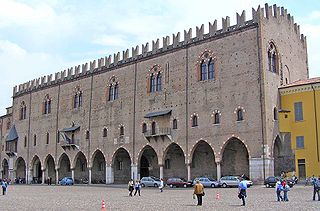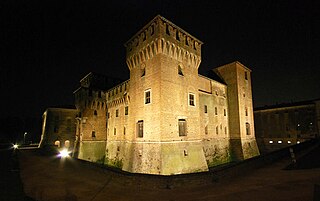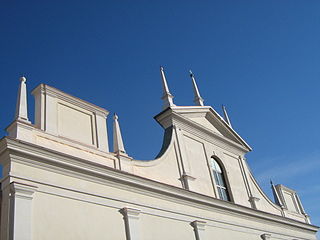

The Basilica Palatina di Santa Barbara is the Palatine Chapel of the House of Gonzaga in Mantua, Italy.


The Basilica Palatina di Santa Barbara is the Palatine Chapel of the House of Gonzaga in Mantua, Italy.
Built at the request of the Duke Guglielmo Gonzaga and built by the Mantuan Architect Giovan Battista Bertani, the monument was erected in two phases, from 1562 to 1567 and from 1569 to 1572, and from 1565 the religious court ceremonies were led by the abbots. [1]
The link between the Duke's Palace and the Church, desired by Duke Guglielmo, was closed at the end of the 19th century in order to separate the property of the Italian State from that of the Church because of the conflict that followed the end of the Pope's secular power in 1870. On September 16, 2018, the passage was reopened to the public. [2]
Santa Barbara can be considered the masterpiece of both the client and the builder. It was granted numerous privileges by the Duke to remove it from the Bishop's control and to practice its own rite, which differed from the Roman Rite. It was conceived as a place of rich liturgical ceremonies, accompanied by sacred music at the highest level. The Duke took a personal interest in the organ, built by Graziadio Antegnati, which survives to this day.
The strong earthquake in Emilia on 29 May 2012 caused damage to the dome of the bell tower of the basilica. [3]
The architectural structure is unique. A central structure with a square dome housing in the middle is followed by a raised presbytery, which is covered by a second dome housing similar to the first one, followed by an apsis, which is decorated with peculiar intersecting boxes. The interior is single-nave with side chapels and the adjoining semicircular presbytery. Next to the main altar, a staircase leads to a deep crypt consisting of a rectangular room and an oval shrine. The pilasters consist of simple bands without base and capital.
The brick bell tower, crowned by a small round temple, is one of the most characteristic elements of Mantua's urban landscape. The model that inspired the court architect Giovan Battista Bertani is the Tempietto di Bramante of San Pietro in Montorio by Donato Bramante, where after the visit of Sebastiano Serlio and Andrea Palladio he replaced the vitruvian beam with a Venetian window.
Inside, on the two side altars designed by Giovan Battista Bertani, there are two large paintings by Lorenzo Costa the Younger, the Baptism of Constantine and the Martyrdom of St. Hadrian. Other paintings are the altarpiece in the presbytery with the Martyrdom of Saint Barbara by Domenico Brusasorci (1564), the Annunciation on one side of the organ doors by Fermo Ghisoni and on the other side the Saints Barbara and Peter (circa 1566).


In the basilica is a pipe organ built in 1565 by the organ builder Graziadio Antegnati and restored and reconstructed in the years 1995-2006 by Giorgio Carli from Pescantina. 312 pipes are preserved from the Antegnati workshop. [4]
The instrument is equipped with a manual and a hung pedal. The manual has seven split upper keys for subsemitonics (dis/es, gis/as). The organ is housed in a richly carved, gilded Renaissance case which is placed above the choirs in the Cornu Epistulae. The prospectus can be closed by two doors attributed to Fermo Ghisoni and on the outside it shows the holy Saint Barbara and the holy Petrus, on the inside the Annunciation. The disposition is as follows:
|
| |||||||||||||||||||||||||||||||
Organists at the basilica have included Ruggier Trofeo. [5]
Important members of the Gonzaga dynasty who were found during restoration work in 2007 were buried in the Palatina Basilica: [6] [7]
{{cite book}}: CS1 maint: location missing publisher (link){{cite book}}: |work= ignored (help){{cite book}}: |work= ignored (help)
Mantua is a comune (municipality) in the Italian region of Lombardy, and capital of the province of the same name.

Ludovico III Gonzaga of Mantua, known as the Turk, also spelled Lodovico was the ruler of the Italian city of Mantua from 1444 to his death in 1478.

Eleonora Gonzaga, was born a princess of Mantua as a member of the House of Gonzaga, and by marriage to Ferdinand II, Holy Roman Emperor, was Holy Roman Empress, German Queen, Queen of Hungary and Bohemia.

Guglielmo Gonzaga was Duke of Mantua from 1550 to 1587, and of Montferrat from 1574 to 1587. He was the second son of Federico II Gonzaga, Duke of Mantua and Margaret Palaeologina of Montferrat. In 1574, Montferrat was elevated to a Duchy and Guglielmo became its first duke. He was succeeded as Duke of both duchies by his son Vincenzo.

The Palazzo Ducale di Mantova is a group of buildings in Mantua, Lombardy, northern Italy, built between the 14th and the 17th century mainly by the noble family of Gonzaga as their royal residence in the capital of their Duchy. The buildings are connected by corridors and galleries and are enriched by inner courts and wide gardens. The complex includes some 500 rooms and occupies an area of c. 34,000 m2, which make it the sixth largest palace in Europe after the palaces of the Vatican, the Louvre Palace, the Palace of Versailles, the Royal Palace of Caserta and the Castle of Fontainebleau. It has more than 500 rooms and contains seven gardens and eight courtyards. Although most famous for Mantegna's frescos in the Camera degli Sposi, they have many other very significant architectural and painted elements.

Margherita Barbara Gonzaga, was an Italian noblewoman, Duchess consort of Ferrara, Modena and Reggio between 1579 and 1597 by marriage to Alfonso II d'Este, Duke of Ferrara, Modena and Reggio. She was a significant cultural patron in Ferrara and Modena.

Mantua Cathedral in Mantua, Lombardy, northern Italy, is a Roman Catholic cathedral dedicated to Saint Peter. It is the seat of the Bishop of Mantua.

Adriana Basile was an Italian composer and singer.

The Diocese of Mantua is a Latin Church ecclesiastical territory or diocese of the Catholic Church in Italy. The diocese existed at the beginning of the 8th century, though the earliest attested bishop is Laiulfus (827). It has been a suffragan of the Archdiocese of Milan since 1819.

Andrea Seghizzi or Sghizzi was an Italian painter of the Baroque period, active mainly in Bologna.

Francesco Gonzaga was an Italian bishop and a Cardinal of the Roman Catholic Church during the reigns of Popes Pius II, Paul II and Sixtus IV.

Frans Geffels, known in Italy as Francesco Geffels, was a Flemish painter, printmaker, architect, stage designer and designer of ephemeral structures for solemn and festive occasions. After training in his native Antwerp, he was mainly active in Mantua, where he was prefetto delle fabbriche to the Duke, a role that gave him the direction of the artistic and construction activities undertaken by the Ducal court. He worked also on projects for the local aristocratic class of Mantua. In addition, he completed projects for the Liechtenstein princes and for the imperial court in Vienna.
Costanzo Antegnati was an organist, organ builder and composer.

The Marquisate or Margraviate of Mantua was a margraviate located in Lombardy, Northern Italy. Placed under the sovereignty of the House of Gonzaga since its erection in 1433, it was further raised to Duchy in 1530.

Bernardino Facciotto (1540–1598) was an Italian military and civil architect who was born and died in Casale Monferrato.
The Studiolo of Isabella d'Este was a special private study, first in castello di San Giorgio, later the Studiolo was moved to the Corte Vecchi apartments in the Ducal Palace in Mantua, designed by, and with a collection of art specially commissioned by Isabella d'Este.

The Castello di San Giorgio is part of the Ducal palace of Mantua. It is a moated rectangular castle, each of which's four corners has a large tower and the moat is crossed by three drawbridges.

Antonio della Mola was a 16th-century Italian artist who worked in intaglio and wood-inlay, as well as producing sculptures in marble.

The Fasti of the Gonzagas or Gonzaga Cycle is a 1578-1580 cycle of oil on canvas paintings commissioned from Tintoretto and his workshop by Guglielmo Gonzaga to hang in two of the new rooms he had added to the Palazzo Ducale in Mantua. They celebrate the history of the Gonzaga family, particularly its military triumphs in the 15th and 16th centuries, and remained in the city until being taken to Venice in the early 18th century by the tenth and final Gonzaga duke Ferdinando Carlo Gonzaga. There they were bought in 1708 by Maximilian II Emanuel, Elector of Bavaria for his collection in Munich, where they still hang in the Alte Pinakothek.

Sant'Erasmo is a Roman Catholic church located in Castel Goffredo, region of Lombardy, Italy.